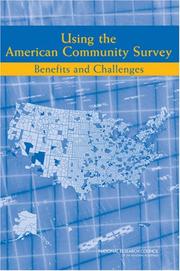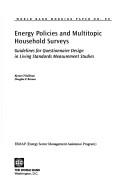| Listing 1 - 10 of 13 | << page >> |
Sort by
|
Book
ISBN: 0896297675 9780896297678 Year: 2007 Publisher: Washington IFPRI
Abstract | Keywords | Export | Availability | Bookmark
 Loading...
Loading...Choose an application
- Reference Manager
- EndNote
- RefWorks (Direct export to RefWorks)
Diet --- Food consumption --- Food supply --- Household surveys
Book
Year: 2007 Publisher: [Washington, D.C.] : U.S. Dept. of Agriculture, Economic Research Service,
Abstract | Keywords | Export | Availability | Bookmark
 Loading...
Loading...Choose an application
- Reference Manager
- EndNote
- RefWorks (Direct export to RefWorks)
Food consumption --- Household surveys --- Nutrition surveys --- Costs
Book
ISBN: 1435612728 Year: 2007 Publisher: [Place of publication not identified] United Nations
Abstract | Keywords | Export | Availability | Bookmark
 Loading...
Loading...Choose an application
- Reference Manager
- EndNote
- RefWorks (Direct export to RefWorks)
Agriculture --- Farm income --- Rural development --- Household surveys --- Economic aspects

ISBN: 1280969040 9786610969043 0309106737 9780309106733 9781280969041 0309106729 9780309106726 6610969043 Year: 2007 Publisher: Washington, DC : National Academies Press,
Abstract | Keywords | Export | Availability | Bookmark
 Loading...
Loading...Choose an application
- Reference Manager
- EndNote
- RefWorks (Direct export to RefWorks)
"The American Community Survey (ACS) is a major new initiative from the U.S. Census Bureau designed to provide continuously updated information on the numbers and characteristics of the nation's people and housing. It replaces the "long form" of the decennial census. This report of a panel of the National Research Council's Committee on National Statistics provides detailed, comprehensive analysis and guidance for users in federal, state, and local government agencies, academia, and the media." "Chapters for users cover the basics of how the ACS design and operations differ from the long-form sample, using the ACS for such applications as formula allocation of federal and stale funds, transportation planning, and public information; and challenges in working with ACS estimates that cover periods of 12, 36, or 60 months depending on the population size of an area." "The report also recommends priority areas for continued research and development by the Census Bureau to guide the evolution of the ACS."--Jacket
Book
ISBN: 128095048X 9786610950485 1435670337 9781280950483 9781435670334 Year: 2007 Publisher: Ithaca, N.Y. : New Strategist Publications,
Abstract | Keywords | Export | Availability | Bookmark
 Loading...
Loading...Choose an application
- Reference Manager
- EndNote
- RefWorks (Direct export to RefWorks)
Explores the economic status of Americans and provides the latest data on the wealth of American households. Examines household income trends by age, household type, race and ethnicity, education, region of residence, and work status. Also focuses on the poverty population.
Consumers' preferences --- African American consumers --- Hispanic American consumers --- Income --- Income distribution --- Discretionary income --- Poverty --- Household surveys --- United States --- Economic conditions
Book
Year: 2007 Publisher: Ithaca, New York : New Strategist Publications,
Abstract | Keywords | Export | Availability | Bookmark
 Loading...
Loading...Choose an application
- Reference Manager
- EndNote
- RefWorks (Direct export to RefWorks)
Presents a broad overview of household spending in the year 2005 and is designed to give researchers insights into consumer spending patterns and how those patterns differ based on various demographic characteristics.
Transportation --- Motor vehicle industry --- Local transit --- Consumption (Economics) --- Consumers --- Consumers' preference --- Household surveys --- Cost and standard of living --- Finance, Personal --- Consumers' preferences

ISBN: 1280654325 9786610654321 0821368796 0821368788 Year: 2007 Publisher: Washington, D.C. : World Bank,
Abstract | Keywords | Export | Availability | Bookmark
 Loading...
Loading...Choose an application
- Reference Manager
- EndNote
- RefWorks (Direct export to RefWorks)
The Energy Sector Management Assistance Program (ESMAP) is a global technical assistance program that promotes the role of energy in poverty reduction and economic growth with redistribution. ESMAP undertakes analytical work and provides policy advice on sustainable energy development to governments and other institutions in developing countries and economies in transition. ESMAP was established in 1983 under the joint sponsorship of the World Bank and the United Nations Development Programme as a partnership in response to global energycrises. Since its creation, ESMAP has operated in some 10
Cost and standard of living. --- Household surveys. --- Households --- Energy consumption. --- Surveys, Household --- Comfort, Standard of --- Cost of living --- Food, Cost of --- Household expenses --- Living, Cost of --- Living, Standard of --- Standard of living --- Surveys --- Census --- Consumption (Economics) --- Home economics --- Quality of life --- Wealth --- Luxury --- Prices --- Purchasing power --- Wages --- Population --- Families
Book
ISBN: 193358890X 1933588500 1933588292 9781933588506 9781933588650 1933588659 9781933588902 Year: 2007 Publisher: Ithaca, New York : New Strategist Publications,
Abstract | Keywords | Export | Availability | Bookmark
 Loading...
Loading...Choose an application
- Reference Manager
- EndNote
- RefWorks (Direct export to RefWorks)
The eleventh edition of Who's Buying at Restaurants and Carry-Outs is based on unpublished data collected by the Bureau of Labor Statistics' 2012 Consumer Expenditure Survey-you can't get these data online. It examines how much Americans spend on eating out by the demographics that count: age, income, high-income households, household type, race and Hispanic origin, region of residence, and education. To round out the spending picture, it also presents who-are-the-best-customers analyses of the data, showing the demographics of the best and biggest customers at a glance. The report looks at spending on breakfast, lunch, dinner, and snacks consumed at fast-food and full-service restaurants, employer and school cafeterias, and vending machines and mobile vendors.
Business & Economics --- Economic History --- Restaurants --- Food consumption --- Consumers' preferences --- Market surveys --- Brand preferences --- Choice (Economic theory) --- Choice of product --- Preferences, Consumers' --- Product choice --- Consumer behavior --- Consumers --- Revealed preference theory --- Cafés --- Dining establishments --- Restaurants, lunch rooms, etc. --- Food service --- Happy hours --- Attitudes --- E-books --- Consumption (Economics) --- Consumers' preference --- Household surveys --- Cost and standard of living --- Finance, Personal
Book
Year: 2007 Publisher: Washington, D.C., The World Bank,
Abstract | Keywords | Export | Availability | Bookmark
 Loading...
Loading...Choose an application
- Reference Manager
- EndNote
- RefWorks (Direct export to RefWorks)
The authors report new estimates of measures of absolute poverty for the developing world over 1981-2004. A clear trend decline in the percentage of people who are absolutely poor is evident, although with uneven progress across regions. They find more mixed success in reducing the total number of poor. Indeed, the developing world outside China has seen little or no sustained progress in reducing the number of poor, with rising poverty counts in some regions, notably Sub-Saharan Africa. There are encouraging signs of progress in reducing the incidence of poverty in all regions after 2000, although it is too early to say if this is a new trend.
Absolute Poverty --- Child Mortality --- Food Consumption --- Global Poverty --- Health, Nutrition and Population --- Household Size --- Household Surveys --- Household Welfare --- Incidence of Poverty --- Income --- Inequality --- Per Capita Consumption --- Poor --- Poor People --- Population Policies --- Poverty Gap --- Poverty Gap Index --- Poverty Measurement --- Poverty Measures --- Poverty Reduction --- Rural --- Rural Development --- Rural Poverty --- Rural Poverty Line --- Rural Poverty Reduction
Book
Year: 2007 Publisher: Washington, D.C., The World Bank,
Abstract | Keywords | Export | Availability | Bookmark
 Loading...
Loading...Choose an application
- Reference Manager
- EndNote
- RefWorks (Direct export to RefWorks)
This paper explores the impact of remittances on poverty, education, and health in 11 Latin American countries using nationally representative household surveys and making an explicit attempt to account for one of the inherent costs associated with migration-the potential income that the migrant may have made at home. The main findings of the study are the following: (1) regardless of the counterfactual used remittances appear to lower poverty levels in most recipient countries; (2) yet despite this general tendency, the estimated impacts tend to be modest; and (3) there is significant country heterogeneity in the poverty reduction impact of remittances' flows. Among the aspects that have been identified in the paper that may lead to varying outcomes across countries are the percentage of households reporting remittances income, the share of remittances of recipient households belonging to the lowest quintiles of the income distribution, and the relative importance of remittances flows with respect to GDP. While remittances tend to have positive effects on education and health, this impact is often restricted to specific groups of the population.
Debt Markets --- Finance and Financial Sector Development --- Health, Nutrition and Population --- Household Surveys --- Human Capital --- Macroeconomics and Economic Growth --- Migrant --- Migration --- Policy Research --- Policy Research Working Paper --- Population Policies --- Poverty Reduction --- Progress --- Recipient countries --- Remittances --- Respect --- Rural Development --- Rural Poverty Reduction
| Listing 1 - 10 of 13 | << page >> |
Sort by
|

 Search
Search Feedback
Feedback About UniCat
About UniCat  Help
Help News
News